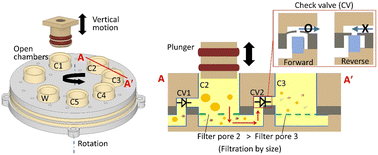Size-selective filtration of extracellular vesicles with a movable-layer device†
Abstract
This paper presents a microfluidic device that can isolate extracellular vesicles (EVs) with multiple size intervals in a simple, effective, and automated manner. We accomplish this size-selective separation using a vertically movable plunger and a rotationally movable chip. The chip has open chambers with nanoporous filters that are sequentially connected by check valves. The plunger speed is adjusted to reduce chamber pressurization in order to prevent EV deformation, thereby achieving a high separation resolution. Herein, high-purity EVs with a purity ten times higher than that of ultracentrifugation were obtained by washing three times with a high EV recovery rate of 89%. For the analysis of device performance, we used polymer nanobeads, preformed liposomes, and canine blood plasma. To demonstrate the utility of the device, we applied size-selective isolation to EVs that were secreted by endothelial cells under shear flow. The results revealed that the cells secreted more EVs of larger size, the expression of CD63 protein was higher for EVs with a larger size, and a high amount of TSG101 protein was expressed under the condition of no shear flow. This device is envisioned to facilitate molecular analysis and EV-based biomarker discovery that use various biofluids, including blood plasma, urine, and cell culture supernatants. Our device automates size-selective EV filtration that requires laborious multiple washing and separation steps.

- This article is part of the themed collection: Lab on a Chip HOT Articles 2022


 Please wait while we load your content...
Please wait while we load your content...